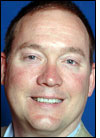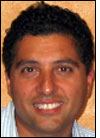May 31, 2010When Hospital Israelita Albert Einstein (HIAE) began seeking a real-time locating system (RTLS), it took a holistic approach. The Brazilian hospital identified a vendor, AeroScout, to provide a system to include RFID tags that could be tracked by the facility's existing Cisco Unified Wireless Network Wi-Fi system for voice over IP. It then gathered all of its departments together, in order to develop a plan.
The hospital held a one-week workshop in early 2009, including members of its security, nursing, pharmaceuticals, laboratories, biomedical and facilities departments—as well as Joel Cook, AeroScout's health-care solutions marketing director—to discuss where its inefficiencies lie, as well as how RTLS and RFID technologies could benefit them. Ultimately, HIAE developed a three-phase plan, beginning with temperature tracking in cooling units, followed by asset management and, eventually, the tracking of individual patients in the hospital. To date, the first two phases have been completed, and phase three, patient tracking, will take place in the next 18 months.
HIAE, a 489-bed hospital in São Paulo, serves one of Brazil's wealthiest communities. Its patients typically have high expectations for medical care and service. According to Sergio Arai, HIAE's CIO, the facility—often described as one of the most advanced hospitals in the world—"is known for its expertise and long-standing commitment to improving patient safety." The hospital was the first to receive Joint Commission International accreditation, which requires, in part, that a hospital track the temperatures in its coolers for storing blood, tissue samples and pharmaceuticals. Previously, staff members employed a manual method to meet those needs (reading thermometers and writing the results on paper), but it was a time-consuming way to monitor the temperatures of 211 cooling units located in a variety of places within the five-building facility, which spans 86,000 square meters (926,000 square feet). In addition, the RFID temperature-tracking system could be put in place very quickly, by simply attaching tags to each unit, and installing AeroScout's Mobile View software to translate and store data. as well as send alerts when necessary.
The hospital considered RTLS solutions provided by numerous vendors, Arai says, but, "felt that AeroScout had the deepest knowledge and health-care expertise in RTLS." What's more, it liked the fact that a version of the Mobile View software system was available in Brazilian Portuguese.
When it came to temperature tracking, the manual system not only was a time-consuming process, but also provided insufficient detail, since temperatures were not checked as often as they would be using an automated system. As a result, it was not always clear whether the temperature in a particular refrigerator or freezer had crossed an acceptable threshold, thereby necessitating the discarding of items within that unit.
AeroScout provided three different tag models for the temperature-monitoring solution—the T5A, for standard refrigerators; the T5B, for freezers that drop to -70 degrees Celsius (-94 degrees Fahrenheit); and the T5C, for cryogenic containers that use liquid nitrogen to reach -200 degrees Celsius (-328 degrees Fahrenheit). for storing tissue such as bone marrow and stem cells. For cryogenic containers, Cook explains, the tags were tested and modified to ensure they could withstand the extreme cold, though he declines to specify what modifications were made.
With each installation, a temperature probe is placed inside the unit, says Ricardo Berrios, AeroScout's managing director for Latin America, and wired to the tag, which transmits the temperature, along with its own unique ID number, at 2.4 GHz to Cisco Wi-Fi nodes installed throughout the facility. The ID number and temperature reading are then received by the Mobile View software residing on HIAE's back-end system, which stores that information. In the event of an unacceptable temperature fluctuation, Berrios says, an alert is transmitted to management via an e-mail or text message.
The temperature-tracking system went live in the third quarter of 2009, while the asset-tracking system went live this month.
"The biggest benefit we have seen," Arai says, "is the increase in staff productivity" of the asset-tracking system. Before implementing the real-time locating system, he says, "our team had to physically search for equipment. Now, nurses only have to look at the software and see where it is in the system." In addition, while the hospital. in the past, kept spare infusion pumps on hand to replace equipment that could not be found, it now requires only 500 infusion pumps, which can easily be located via the Mobile View system.
"Our patients benefit because our staff is able to provide fast service and quickly meet patient needs," Arai says. "For example, if we need to find a wheelchair, it only takes seconds to find one, whereas before, it would take minutes."
The next step is to expand the software's use to enable the hospital to track the maintenance schedules of its equipment. For example, its own SAP system could alert management via e-mail when an item is due for maintenance, and a hyperlink could be provided that would access the Mobile View software data, indicating the specific area of the hospital in which the item is located.
Eventually, Arai says, HIAE hopes to use the AeroScout tags to track patients, though he declines to provide the specifics of that deployment. In addition, the hospital plans to grow in size, and expects the asset-tracking system to grow with it as it expands, thereby allowing the tracking of assets in any location within the exiting or added buildings.




